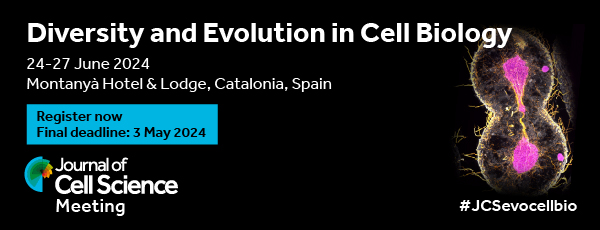Issues
-
Cover image
Cover Image

Cover: AiryScan image of a HeLa cell in which mitochondria are depolarized with CCCP for 1 min, showing robust actin filament assembly (green) around the depolarized mitochondria (red). Actin polymerization depends upon the Arp2/3 complex and inhibits depolarization-induced mitochondrial shape changes. See article by T. S. Fung et al. (jcs234435).
- PDF Icon PDF LinkTable of contents
- PDF Icon PDF LinkIssue info
RESEARCH HIGHLIGHTS
EDITORIAL
STICKY WICKET
FIRST PERSON
CELL SCIENCE AT A GLANCE
The fusogenic synapse at a glance
Summary: Cell–cell fusion is promoted by invasive protrusions and mechanosensory responses at the asymmetric fusogenic synapse.
REVIEW
Force-generating mechanisms of anaphase in human cells
Summary: A Review of contributions of force-generating mechanisms, acting through different microtubule populations, to chromosome segregation in human cells.
SHORT REPORT
Phosphorylation of connexin 43 at MAPK, PKC or CK1 sites each distinctly alter the kinetics of epidermal wound repair
Summary: Cx43 plays a key role in wound healing and Cx43 modulators are used in clinical trials. We tested the importance and roles of specific Cx43 phosphorylation sites during wound repair.
RESEARCH ARTICLES
First meiotic anaphase requires Cep55-dependent inhibitory cyclin-dependent kinase 1 phosphorylation
Summary: Proteolysis mediated by the anaphase-promoting complex is not sufficient for inducing anaphase I in mouse oocytes and Cep55-dependent phosphoinhibition of cyclin-dependent kinase 1 is also required.
Septate junctions regulate gut homeostasis through regulation of stem cell proliferation and enterocyte behavior in Drosophila
Highlighted Article: Depletion of smooth septate junction-associated proteins from enterocytes in the Drosophila adult midgut results in intestinal hypertrophy accompanied by accumulation of morphologically aberrant enterocytes and increased stem cell proliferation.
Ankyrin-G induces nucleoporin Nup358 to associate with the axon initial segment of neurons
Highlighted Article: In cultured neurons, Nup358 is present at the nuclear rim associated with nuclear pore complex proteins, as well in the cytoplasm and the axon initial segment (AIS), dependent on the AIS scaffold Ankyrin-G.
Longer collagen fibers trigger multicellular streaming on soft substrates via enhanced forces and cell–cell cooperation
Summary: Longer collagen fibers promote collective cell streaming on soft gels via mechanoactivation, velocity coordination, and cell–cell cooperation. Coating of collagen fibers of tunable lengths is enabled by aldehyde-functionalized polyacrylamide hydrogels.
Keratins regulate Hsp70-mediated nuclear localization of p38 mitogen-activated protein kinase
Summary: Keratin 8 interacts with p38 MAPK via a specific docking site and modulates formation of the p38-Hsp70 complex, which regulates the subcellular localization of p38 MAPK.
Phosphorylation of importin-α1 by CDK1–cyclin B1 controls mitotic spindle assembly
Summary: Phosphorylation of importin-α1 by cyclin-dependent kinase 1 provides spatial and temporal control of mitotic spindle assembly through the release of spindle-assembly factors from inhibitory complexes during mitosis.
Two distinct actin filament populations have effects on mitochondria, with differences in stimuli and assembly factors
Highlighted Article: Mitochondrial depolarization induces Arp2/3 complex-dependent actin clouds that restrain OMA1-induced mitochondrial shape changes. A distinct actin network stimulates calcium-induced mitochondrial fission.
Kinesin-8 and Dis1/TOG collaborate to limit spindle elongation from prophase to anaphase A for proper chromosome segregation in fission yeast
Summary: The kinesin-8 Klp5-Klp6 relies on tailbox motifs for processivity, thereby inducing catastrophe and destabilising MTs. Klp5-Klp6 and Dis1/TOG, acting in concert, impose an upper spindle length for viable chromosome segregation in fission yeast.
CORRECTION
PREPRINT HIGHLIGHTS
Introducing our new Editors

We welcome three new Editors to Journal of Cell Science - Robert Parton, Richa Rikhy and Simon Cook. You can read more about them in the Editorial from our Editor-in-Chief Michael Way.
2024 Journal Meeting 'Diversity and Evolution in Cell Biology'

Registration is open for our 2024 Journal Meeting Diversity and Evolution in Cell Biology, which aims to bring together evolutionary biologists and cell biologists investigating diverse aspects of cellular physiology. Final registration deadline: 3 May 2024.
Workshop: Physics of the Early Embryonic Cell Divisions

Early-career researchers interested in the roles of nuclear lipids, apply now for one of the ten funded places at this Workshop, which will take place 11-14 November 2024. Application deadline: 17 May.
Reasons to submit to Journal of Cell Science

There are many benefits to publishing in Journal of Cell Science - read more about why you should choose JCS or visit our submission page now.
Propose a new Workshop for 2026

We are now accepting proposals for our 2026 Workshops programme. We aim to be responsive to the community and open to novel initiatives, so if you have a new idea for a biological workshop that you feel would work well, please apply. Applications deadline: 19 July 2024.



